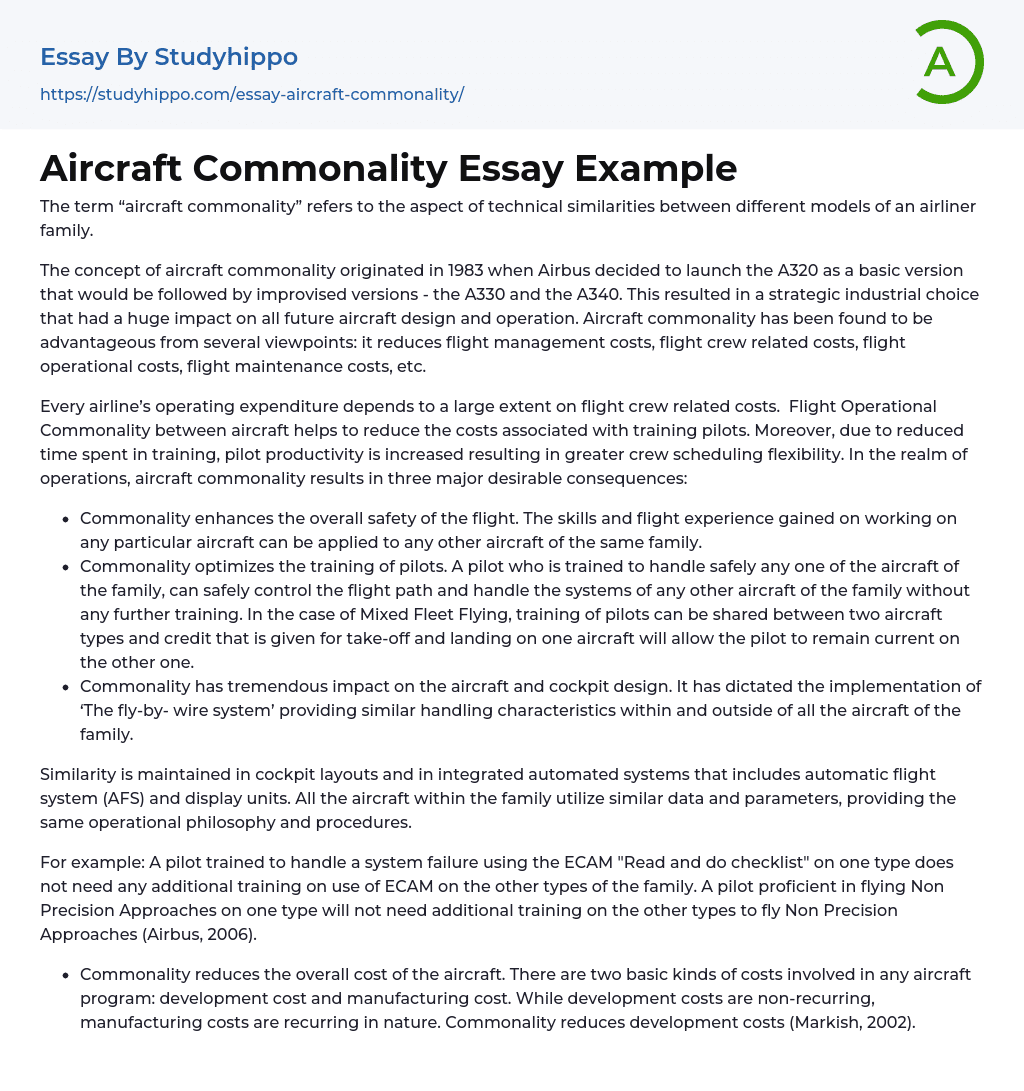The term “aircraft commonality” refers to the aspect of technical similarities between different models of an airliner family.
The concept of aircraft commonality originated in 1983 when Airbus decided to launch the A320 as a basic version that would be followed by improvised versions - the A330 and the A340. This resulted in a strategic industrial choice that had a huge impact on all future aircraft design and operation. Aircraft commonality has been found to be advantageous from several viewpoints: it reduces flight management costs, flight crew related costs, flight operational costs, flight maintenance costs, etc.
Every airline’s operating expenditure depends to a large extent on flight crew related costs. Flight Operational Commonality between aircraft helps to reduce the costs associated with
...training pilots. Moreover, due to reduced time spent in training, pilot productivity is increased resulting in greater crew scheduling flexibility. In the realm of operations, aircraft commonality results in three major desirable consequences:
- Commonality enhances the overall safety of the flight. The skills and flight experience gained on working on any particular aircraft can be applied to any other aircraft of the same family.
- Commonality optimizes the training of pilots. A pilot who is trained to handle safely any one of the aircraft of the family, can safely control the flight path and handle the systems of any other aircraft of the family without any further training. In the case of Mixed Fleet Flying, training of pilots can be shared between two aircraft types and credit that is given for take-off and landing on one aircraft will allow the pilot to remain current
on the other one.
Similarity is maintained in cockpit layouts and in integrated automated systems that includes automatic flight system (AFS) and display units. All the aircraft within the family utilize similar data and parameters, providing the same operational philosophy and procedures.
For example: A pilot trained to handle a system failure using the ECAM "Read and do checklist" on one type does not need any additional training on use of ECAM on the other types of the family. A pilot proficient in flying Non Precision Approaches on one type will not need additional training on the other types to fly Non Precision Approaches (Airbus, 2006).
- Commonality reduces the overall cost of the aircraft. There are two basic kinds of costs involved in any aircraft program: development cost and manufacturing cost. While development costs are non-recurring, manufacturing costs are recurring in nature. Commonality reduces development costs (Markish, 2002).
When an aircraft about to be developed is a derivative of an existing design, the hypothetical derivative may have a high degree of commonality with the aircraft already in production - for example it may use the same wing, or the same fuselage section or even both. In such a case, the non-recurring cost for those components of the aircraft that already exist should be significantly lowered from the baseline case of an all-new design.
- Low-Cost Carrier essays
- Easyjet essays
- Non-Commissioned Officer essays
- Auction essays
- Balanced Scorecard essays
- Business Plans essays
- Expense essays
- Income essays
- Net Income essays
- Security Guard essays
- Singapore Airlines essays
- Battle essays
- Intranet essays
- Maintenance essays
- Simulation essays
- Inn essays
- Business Law essays
- Contract essays
- Consumer Protection essays
- Property essays
- Ownership essays
- Agreement essays
- Common Law essays
- Contract Law essays
- Justice essays
- Security essays
- Tort Law essays
- United States Constitution essays
- Crime essays
- Lawsuit essays
- Treaty essays
- Family Law essays
- Marijuana Legalization essays
- Constitution essays
- War on Drugs essays
- Court essays
- Jury essays
- Police essays
- Protection essays
- Community Policing essays
- Criminal Law essays
- Judge essays
- Lawyer essays
- Employment Law essays
- Copyright Infringement essays
- Injustice essays
- Intellectual Property essays
- Breach Of Contract essays
- Jurisprudence essays
- Social Injustice essays




